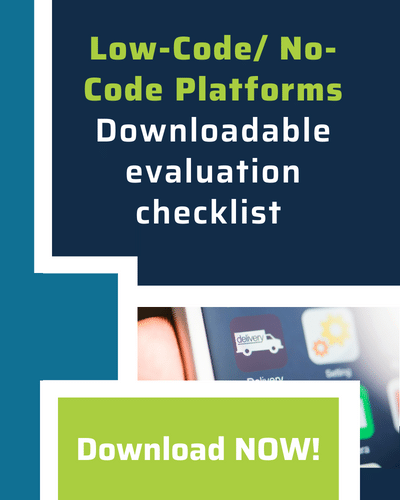Corporations that use SAP ERP software are no stranger to ABAP. Originally developed in the 1980s, ABAP is a high-level, fourth-generation programming language designed by SAP that is used by developers to customize SAP ERP platforms. ABAP helps to customize workflows for materials management, asset management, and more. It was specifically designed to allow for the mass-processing of data in SAP business applications, helping to solve challenges with time-consuming manual processes and data overflow.
In this blog, we’ll further explain the concept of coding in relation to ABAP, define what ABAP is and its meaning, why SAP created ABAP and why SAP rapid application development platforms such as EdgeReady Cloud helps ABAP developers to modernize their business processes.
The Concept of Coding and ABAP
Before diving into what ABAP is, it’s important to highlight how it ties to coding and programming. Developers use ABAP to select from procedural and object-oriented programming within SAP with the hopes of improving SAP-based applications. ABAP code can be written in two different forms. The first, source code, can be viewed and edited through ABAP Workbench tools. The second form is called generated code.
ABAP implementable programs are divided into two types: the reports and module pools. Its non-implementable programs are subroutines pool, function groups, object classes, and interface pool.
ABAP language is an easily understood program for programmers. Nevertheless, it is not a great tool to be used by non-programmers, and involves quite complex features.
What Is ABAP?
ABAP stands for advanced business application programming, but is commonly referred to as ABAP. ABAP is a high-level programming language created by SAP that helps large corporations customize their SAP ERP platform. It is the main programming language that CRM, S/4HANA, SAP ERP, and SAP NetWeaver ABAP platforms and application servers support. While some solutions, such as SAP Business One, SAP Ariba, and acquired products like SAP Concur and SAP SuccessFactors, run primarily on other languages, ABAP will still play a role when these solutions integrate with a central, ABAP-based SAP ERP or SAP S/4HANA system. ABAP allows SAP customers to customize workflows for financial accounting, asset management, materials management, and all other SAP modules. Read more on ABAP Development Tools for SAP NetWeaver.
Why SAP Created ABAP
SAP initially created ABAP in the 1980s for SAP R/2 with the intention of SAP customers using it to enhance their SAP applications. ABAP was derived from COBOL and initially designed for SAP R/2 running in mainframes. With the advent of Client-server, ABAP was modified to fit into the Client-Server technology but carried a lot of remnants from SAP R/2 into SAP R/3 and subsequently into the current versions of SAP. ABAP gave customers the ability to create custom reports and interfaces, but the language itself was catered towards more technical customers with programming experience. The ABAP language was used by technical customers and developers to develop the SAP R/2 first and subsequently R/3, ECC and now S/4HANA ERP applications. So what are some challenges that SAP users who aren’t developers are facing?
Download the free ABAP performance analysis dashboard now
Challenges with ABAP for SAP Users
While ABAP can be easy to use for programmers, it does create roadblocks for SAP users who are not technically inclined. Some of these challenges include:
- Speed-to-market and time consumption
ABAP programming takes time and specialized skills. This slows the speed to market and business stakeholders are turned off by the speed at which ABAP customizations can be delivered. Sometimes depending on the business requirement, it might be too late for the business users.
- High Total Cost of Ownership (TCO)
ABAP is a central system for SAP users, and it performs huge roles in every business organization. This system is well known for its complexity. Additionally, there is a high demand and low supply of professionals with ABAP knowledge and they charge an incredible amount. This can have a huge impact on your total cost of ownership (TCO) for your enterprise software.
- Slower upgrades
Most customers have a lot of ABAP customizations in their SAP environment. The more non-core custom objects there are, the more time and effort is needed every time a patch, service pack or an Enhancement pack needs to be applied to the SAP ERP.
- Unnecessary/ Dead ABAP Code
There is a large amount of unnecessary code that needs removal but gets carried from system to system during upgrades, such as R/3 to ECC to S/4HANA. This only adds to the technical debt that adds to the total cost of maintaining the SAP system. So what should SAP users do to combat these challenges and successfully modernize SAP and support ABAP, without having to gain technical knowledge?
How Pillir Modernizes SAP and Supports ABAP
A lot of corporations still struggle to recognize and properly maintain ABAP and its customization within their SAP systems because of its programming language complexity, cost, time consumption, as well as shortage of top-notch professionals. Pillir offers a rapid application development platform called EdgeReady Cloud that allows business and IT technicians to efficiently come together and deliver new web and mobile applications in no time, while meeting your organizational expectations.
Pillir has solved the problem that many corporations face with creating, recognition, and maintaining ABAP customizations by developing this new diagnostic application. EdgeReady Cloud effectively solves the issues of time, complexity, and cost out of managing and maintaining ABAP modifications. It also identifies the total cost to maintain them as well as how they impact your rate of change and speed to market. With that, your enterprise can modernize business practices, distinguish within the market, and streamline operational workflows.
Watch a 15-minute technical demo
Final Words
ABAP- the SAP embedded coding language, is not only inefficient for custom development compared to other modern high-level programming languages but it also poses problems for SAP users with the high cost of ownership, unnecessary code generation, and more extended operational periods.
Using EdgeReady Cloud and the free ABAP technical debt interactive calculator performance analysis dashboard, you can now save money, lower the total cost of ownership (TCO) of your systems, and eliminate unnecessary custom ABAP code. Install the ABAP Discovery and TCO Analyzer for SAP Customers today. Click here to learn more.






 Back
Back/Logo%20-%20black%20text%20blue%20pillar%20(large)-1.jpg)

